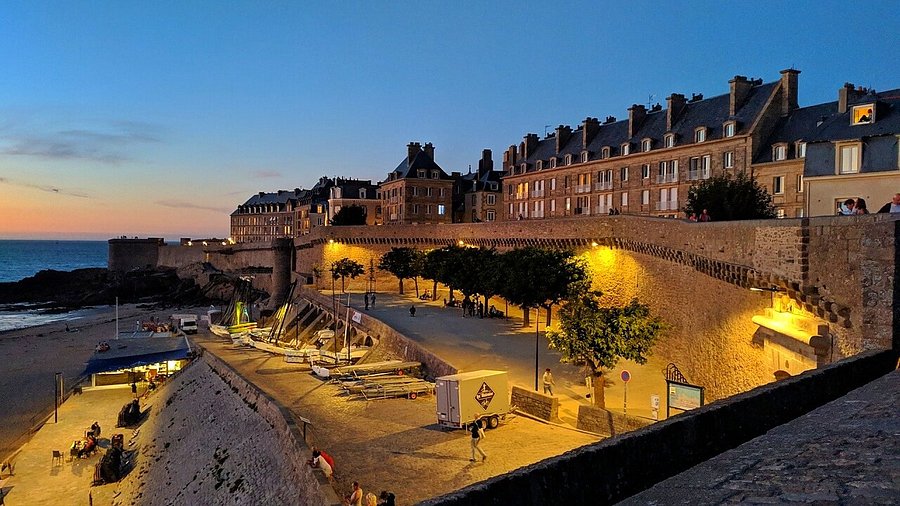Saint-Malo, a historic port city nestled along France’s rugged Brittany coast, is renowned for its remarkable blend of medieval fortifications, maritime heritage, and architectural splendor. Encircled by granite walls and punctuated by soaring spires and sea-battered bastions, the fortified city—known as “Intra-Muros”—offers an unforgettable journey through centuries of French history and design.
Whether you're a first-time visitor or a seasoned traveler, Saint-Malo’s architectural gems provide a captivating glimpse into its storied past. Here are seven must-see landmarks that showcase the city’s astonishing architectural heritage.
1. Saint-Vincent Cathedral: A Masterpiece of Romanesque and Gothic Design
At the heart of Saint-Malo stands the Saint-Vincent Cathedral, a striking fusion of Romanesque and Gothic styles. Founded in the 12th century, the cathedral has undergone several transformations, with significant additions in the 15th and 18th centuries. Its Latin cross layout, soaring vaulted ceilings, and intricate stained glass windows create a serene and awe-inspiring atmosphere. The cathedral's resilience is evident, having been meticulously restored after wartime destruction.
Notable features include the Great Rose Window, reconstructed in 1968, and the 15th-century marble statue of Notre-Dame de la Grand’Porte, a revered symbol of protection for the city. The cathedral's blend of architectural styles and historical significance make it a must-visit landmark.
2. The Ramparts: Walk Through History on Saint-Malo’s City Walls
Encircling the old town, the city’s ramparts are among France’s most impressive medieval fortifications. Built between the 12th and 17th centuries, these granite walls stretch nearly 2 kilometers and offer panoramic views of the sea, beaches, and rooftops. Visitors can walk atop the ramparts, passing through historic gates like the Porte Saint-Vincent and Porte de Dinan. The ramparts not only served as defensive structures but also as vantage points for observing maritime activity.
Walking the ramparts provides a unique perspective of the city, allowing visitors to appreciate the strategic design and historical significance of these fortifications.
3. Fort National: Vauban’s Coastal Fortress
Just offshore, accessible at low tide, lies Fort National—a testament to the military genius of Sébastien Le Prestre de Vauban. Constructed in 1689, this star-shaped granite fortress was designed to protect Saint-Malo’s harbor. Visitors can explore its well-preserved bastions, drawbridges, and panoramic views of the coastline. The fort's strategic location and historical importance make it a fascinating site for history enthusiasts.
4. Château de Saint-Malo: A Fortress Turned Museum
Overlooking the harbor, the Château de Saint-Malo dates back to the 12th century and has served various roles, from a royal fortress to a prison. Today, it houses the Musée d'Histoire de la Ville, offering exhibits on Saint-Malo's maritime history, including its role as a haven for corsairs and explorers. The château's blend of architectural styles and its commanding presence make it a significant landmark in the city.
5. Rue de la Vieille Boucherie: A Glimpse into Medieval Urban Life
Wandering through the narrow cobblestone streets of Saint-Malo, Rue de la Vieille Boucherie stands out as a preserved example of medieval urban design. Lined with timber-framed houses and quaint shops, this street offers a glimpse into the city's past, with architectural features that have withstood the test of time. Exploring such streets provides insight into the daily life and craftsmanship of medieval Saint-Malo.
6. Hôtel de Ville: The Town Hall with a Storied Past
Located near the cathedral, the Hôtel de Ville (Town Hall) is an elegant 18th-century building that reflects the city's civic pride. Its classical façade and grand interiors have witnessed significant events in Saint-Malo's history. The building's architectural style and historical role make it an important part of the city's heritage.
7. The Grand Bé and Petit Bé: Islands with Historical Significance
Accessible by foot at low tide, the islands of Grand Bé and Petit Bé are home to historical structures and offer panoramic views of the city and coastline. Grand Bé is the final resting place of the famous writer Chateaubriand, while Petit Bé features a 17th-century fort. Visiting these islands provides a unique perspective of Saint-Malo's maritime history and natural beauty.
Why France Remains an Essential Travel Destination
Saint-Malo is just one example of France's rich tapestry of history, culture, and architecture. From the sun-kissed vineyards of Bordeaux to the alpine villages of the French Alps, the country offers an unparalleled array of experiences. Whether you're drawn to its world-class cuisine, iconic landmarks, or charming villages, France continues to captivate travelers from around the globe.
Conclusion
Saint-Malo's fortified city is a living museum of architectural marvels, each telling a story of resilience, artistry, and maritime heritage. From the soaring spires of Saint-Vincent Cathedral to the windswept ramparts and coastal forts, the city offers a rich tapestry of experiences for history enthusiasts and casual travelers alike. Exploring these landmarks provides a deeper appreciation for the craftsmanship and strategic ingenuity that have shaped this remarkable city.
For those seeking a destination that seamlessly blends history, architecture, and coastal beauty, Saint-Malo stands as a testament to the enduring allure of France's architectural heritage.








No comments:
Post a Comment